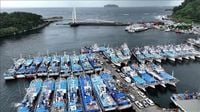On October 18, 2025, Jeju Port in South Korea buzzed with an energy not seen in nearly six decades. For the first time since its designation as a commercial port in 1968, Jeju welcomed an international cargo ship, signaling a bold new chapter for the island’s trade ambitions. The reopening, marked by an official ceremony and the arrival of the Panama-flagged vessel SMC Lezhao, was more than just a logistical milestone—it was a celebration of Jeju’s renewed role in regional commerce and its aspirations for the future.
According to TTXVN, the day’s events kicked off early, as the SMC Lezhao docked at Jeju Port, carrying 40 twenty-foot containers (40 TEU) packed with consumer goods and machinery from Thanh Đảo, China. The cargo ship’s arrival was the first tangible sign of a newly established maritime shipping route between Jeju and Thanh Đảo, a route officials hope will transform the economic landscape for local businesses and residents alike.
The inauguration ceremony at Pier No. 10 was a grand affair, themed “New Maritime Silk Road – Opening a New Future for Jeju.” It drew a roster of dignitaries, including Jeju Governor Oh Young Hoon, Chairman of the Jeju Provincial People’s Council Lee Sang Bong, local legislators, Chairman Zhao Bo of the Viễn Dương Sơn Đông Shipping Group, and Chinese Consul General Qian Jianjun. The symbolism was clear: Jeju was not just opening a shipping route, but forging a new era of cross-border cooperation and opportunity.
Governor Oh Young Hoon, addressing the assembled crowd, wasted no time in highlighting the practical benefits of the new route. “If we export a container through Busan Port, the cost is up to 2.04 million won—about 1,450 US dollars,” he explained. “But through the Thanh Đảo route, it’s only about 770,000 won, reducing expenses by over 60%.” For an island whose economic fortunes have long been shaped by its geographic isolation, such figures are nothing short of transformative.
Jeju’s logistics costs, until now, have been a persistent thorn in the side of local businesses. Exporters and importers have had to contend with lengthy shipping times and high expenses, often routing goods through larger ports like Busan. The new direct route to China, provincial authorities expect, will slash logistics costs by approximately 62.3%, shorten transportation times, and significantly improve the environment for import and export. For many local entrepreneurs, this could mean the difference between thriving and merely surviving.
But the benefits go beyond simple cost savings. Governor Oh also pointed to the impact on Jeju’s construction sector, where prices have historically run about 25% higher than the national average. “Direct import of construction materials via this sea route will help lower Jeju’s construction costs, which in turn will reduce the island’s living costs,” he said. For residents facing rising prices for housing and everyday goods, the promise of relief is welcome news.
Chairman Zhao Bo of the Viễn Dương Sơn Đông Shipping Group echoed the spirit of optimism, framing the new route as a bridge not just for goods, but for people and ideas. “This international container shipping route will not only boost logistics but also expand economic cooperation and cultural exchanges between the two regions,” Zhao said. The company, which currently operates more than 70 vessels on over 40 maritime routes, sees Jeju as a strategic addition to its growing network.
The timing of the port’s reopening is no accident. Jeju officials have their sights set on the island’s 100th anniversary in 2027, and see the new shipping route as a crucial step in transforming Jeju Port into a fully operational international commercial hub. It’s a long-term vision, but one that’s gaining momentum with each new container unloaded on Jeju’s docks.
Just two days before the Jeju ceremony, Governor Oh traveled to Thanh Đảo Port in China for the inauguration of the reciprocal shipping route. There, he reiterated his commitment to expanding not just logistics, but also tourism exchanges between Jeju and China. The move highlights the broader ambitions underpinning the port’s revival: Jeju is positioning itself as a gateway, not just for goods, but for people and cultures across Northeast Asia.
For Jeju’s business community, the new maritime link is a game-changer. The prospect of faster, cheaper shipping opens doors to new markets and suppliers, making it easier for local firms to compete on a regional and global stage. And for residents, the promise of lower construction and living costs could help ease the pressures that have accompanied Jeju’s rapid growth in recent years.
The reopening of Jeju Port also carries symbolic weight. For decades, the island’s commercial ambitions were stymied by logistical hurdles and a lack of direct international connections. Now, with the support of both Korean and Chinese authorities, Jeju is reclaiming its place on the maritime map. The “New Maritime Silk Road” theme of the ceremony was more than just a slogan—it was a nod to the island’s historical role as a crossroads of trade and culture, and a statement of intent for the years ahead.
Of course, the success of the new route will depend on more than just ceremonial fanfare. Sustained investment in port infrastructure, efficient customs procedures, and strong partnerships with shipping companies will be crucial. But for now, the mood in Jeju is one of cautious optimism, buoyed by the sight of international cargo ships once again docking at its shores.
As Jeju looks ahead to its centennial, the reopening of its port serves as a reminder of the island’s enduring resilience and ambition. With a new shipping route in place and a renewed sense of purpose, Jeju is poised to write the next chapter in its storied maritime history—one container at a time.




